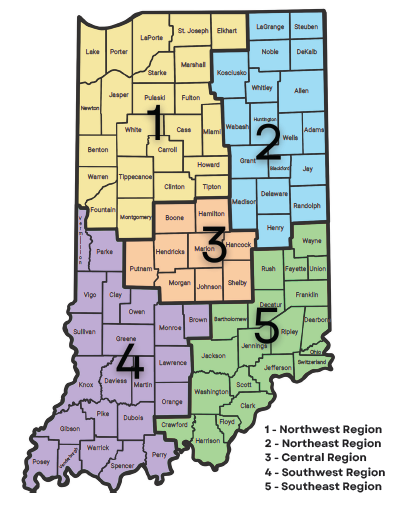Local Food Purchasing Assistance Program
Overview
The USDA Agricultural Marketing Service established the Local Food Purchase Assistance Cooperative Agreement Program (LFPA) and awarded over $400 million in funding through non-competitive cooperative agreements to state and tribal governments, intended to improve supply chain resiliency and support socially disadvantaged farmers and ranchers. LFPA has three fundamental goals:
- The purchase of domestic foods from local, socially disadvantaged farmers and ranchers.
- The distribution of food to socially vulnerable communities that are not normally served, or are underserved, by the normal food distribution network.
- Expanded long-term economic opportunities for local/regional, socially disadvantaged farmers, ranchers, and producers.
In Indiana, the Indiana Department of Health (IDOH) holds the cooperative agreement with USDA and serves the lead state agency, with collaboration and support from the Indiana State Department of Agriculture (ISDA). The effort is being co-lead at IDOH by Women, Infants and Childrenn (WIC) and the Division of Nutrition and Physical Activity (DNPA).
LFPA Tracks
The LFPA allocation for Indiana is $6.9 million, with an additional LFPA Plus allocation of $5,863,175 – with a total award for Indiana of $12,763,175. IDOH has taken a two-pronged approach to the project and split the allocation into two separate tracks.
While the funds from this grant program itself will impact farmers, the hope is that the networking opportunities offered in addition to the funding will provide each farmer the chance to enter new markets, diversify their operation or gain significant knowledge that will benefit their operations upon the conclusion of this grant program.
Track 1
The Indiana WIC Division oversees thirteen regions focused on counties with high levels of socially-disadvantaged (those subject to discrimination on the basis of age, race, color, sex, national origin, disability or religion) residents. Funding flows through an association of food banks which purchases food from socially-disadvantage producers delivering directly to the nearest association member or distribution site.
For more information about LFPA Track 1, visit the LFPA Fresh Connect at https://www.freshconnectcentral.org/lfpa.
Track 2
The Division of Nutrition and Physical Activity oversees a regional approach that divides the state of Indiana into 5 distinct regions. In the summer of 2022, a Request for Proposals (RFP) was released to regional partnership cohorts that focus on the above goals (purchase and distribution of food from local/socially disadvantaged producers) AND long-term economic expansion strategies for producers; awards have now been made to 5 organizations through this RFP process.
Get Started
If you are a farmer or regional stakeholder interested in participating in LFPA Track 2, please contact your regional representative below:
Northwest Indiana Northeast Indiana Central Southwest Indiana Southeast Indiana |  |
Frequently Asked Questions
- Can LFPA funding be used to provide technical assistance to small and socially disadvantaged suppliers and producers?
Yes. Section 4.6.1 of the RFA states that direct costs may be proposed for outreach and program development, which may include technical assistance for socially disadvantaged producers to facilitate participation in the LFPA program. Costs associated with outreach and program development must be directly allocable to LFPA program activities and goals.
- Can LFPA funding be used to pay for GAP certifications, training, seed, or crop insurance?
No. Food safety certifications, training, seed, or crop insurance are examples of production costs. Costs associated with food production activities, or costs associated with general purpose development or training are unallowable. In addition to food purchases, State and Tribal governments may propose direct costs for outreach, program development, program administration, food storage, and distribution expenses.
- Ensure food purchases meet requirements for LFPA program
- Food purchases must meet the LFPA definitions for local and domestic
- Expenses cannot include food safety certifications, training, seed, crop insurance, or other costs associated with production
- Is GAP or GHP certification a requirement for suppliers who participate in this program?
Suppliers that partner or subcontract with State agencies or Tribal Governments under this program are required to follow their state and local regulations regarding food safety.
- Can LFPA funding be used to purchase livestock, live animals, or cattle?
No. Funding can only be used to purchase food items, such as meat, poultry, fruit, vegetables, seafood, dairy, and processed foods.
Meat Producers Only: All meat must have been processed in a USDA certified facility, with the applicable seal
Meat, fish and poultry items must be delivered frozen and individually packaged and labeled.
- What expenses are allowable with LFPA Plus funding?
LFPA Plus funding may only be used for the purchase of unprocessed or minimally processed food, as well as food storage and food distribution costs directly related to the purchase of food. Food purchases must meet the definitions of domestic and local, as defined in Section 1.2.1 of the LFPA Plus RFA.
- Do growers or producers have to be a specific size or produce a certain amount of poundage to participate in LFPA?
Regardless of how much poundage they produce, growers and producers of all sizes are encouraged to participate. We encourage you to partner with lead agencies and community partners with similar capacities or capacities that can handle cold storage and distribution for your amount of product.
- For farmers that are raising livestock, does meat need to be processed at a USDA facility or can an Indiana State facility be okay and what type of license does a meat and/or poultry processing facility need to sell product to a lead agency?
Any producer selling meat and/or poultry to a lead agency must possess a current license with USDA Food Safety Inspection Service. Proof of license will be required prior to selling to a lead agency.
All food must be delivered at appropriate, food safe temperatures:
- Frozen food (meat, fish poultry) should be delivered frozen solid with no signs of temperature abuse including ice crystals, liquid or water marks on bottom of cases.
- Shelled eggs should be delivered at or below 45 degrees Fahrenheit.
- Cold foods should be delivered at or below 41 degrees Fahrenheit.
- Salad greens that are not delivered in a refrigerated truck should be kept unfrozen but cool in some form of cold storage or under an insulated blanket. Drop-Off at WCW Warehouse Location
Individual processed items must be labeled appropriately and disclose any allergen information.
- Can farmers be added or replaced during the program?
Yes, we encourage grantees to add underserved/socially disadvantaged farmers and ranchers as they are identified as a partner that meets the criteria and can assist with carrying out the program workplan and meet the nutritional and cultural food needs in the identified communities. Lead agencies are expected to have some sort of a contractual agreement with farmers, which will allow them to enter and exit the program on a seasonal basis or their production schedule.
Contact
Track 1
Legita Wilson
Women, Infants and Children (WIC)
Commodities Program Manager
lwilson2@health.in.gov
Isis Eynon
Gleaners Community Food Bank
Fresh Connect Supply Chain & Business Development Manager
ieynon@gleaners.org
Track 2
Naima Gardner-Rice
Division of Nutrition and Physical Activity (DNPA)
SNAP-Ed and Nutrition Programs Director
ngardner1@health.in.gov
Denise Jamerson
Local Food Purchasing Assistance (LFPA)
Program Manager
djamerson@health.in.gov

